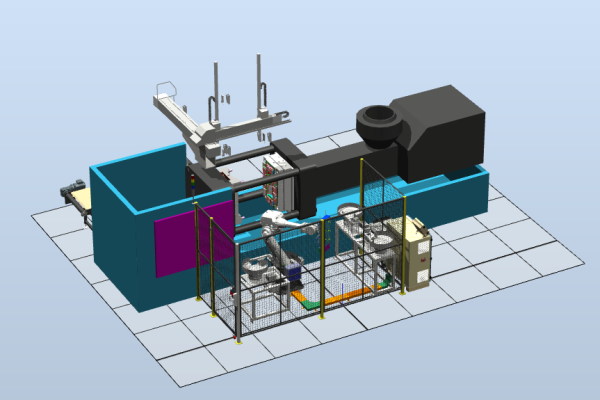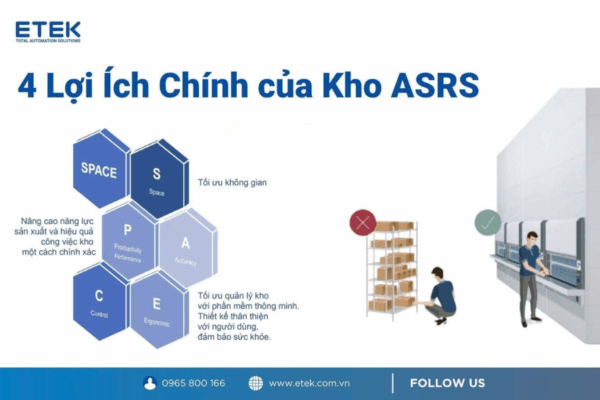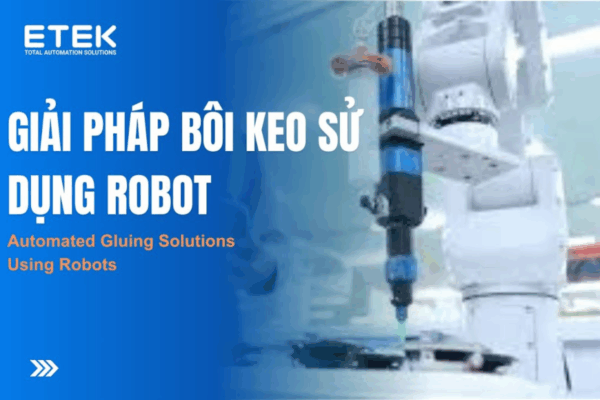Robot delta (Spider Robot) is a line of robots with a distinct design compared to other stationary industrial robots. The name delta comes from its inverted triangle shape. You will see the robotic Delta system mounted above the positioning work area with their large scanning arm. The gripper (working arm) is connected with long and slender mechanical links. These links lead to three or four large motors at the Robot’s legs. Sometimes there are additional motors that allow for more freedom in the gripper.
Automation is a common trend of most modern industries to stay competitive. The specific advantages offered by Delta robots help companies in these industries do just that:
Manufacturing plants in these industries leverage Delta robots to achieve the highest production rates available. The outstanding feature of speed that can reach 300 products/minute is a highlight for factories to choose. In addition, a special advantage is its shell. The motors are placed entirely in the base of the robot making it easy to achieve a high IP rating. This makes Delta robots an excellent choice for IP69K cleaning environments commonly found in the food and beverage industries.
If you’re not sure that Delta robots are a good fit for your factory design? We are always ready to create a connection between you and our experts to test your facility and help you determine which projects are most profitable.
Delta robots are often deployed in a number of applications that take advantage of their unique strengths. Such applications include:
The emergence of Delta robots in applications in the above applications and professions is their unparalleled speed and speed.
You can simply imagine the placement of the motors placed parallel to the working surface, increasing the speed that other robots cannot compare. In the above applications, representing mass production industries, the speed factor is the top priority. Therefore, it is appropriate for robotic Delta systems to perform as well as they can.
As mentioned above, the unique design of the robot system is also a strength that is prioritized by factories. The motor system is located in a base that achieves high IP standards in the manufacturing plant.
An often overlooked advantage of the Delta robot is the efficient use of the workspace, taking advantage of its compact design. The robot may have to be surrounded by a safety cage and other devices but the arm is mounted above the workspace. Therefore, Delta robots are the only robots that use vertical space, which is often not emphasized in manufacturing plants. That makes a difference, the optimal vertical space frees up more floor space for additional equipment and storage.
Of course, in addition to the above-mentioned advantages, the Delta robot has its disadvantages. The biggest advantage is that speed also brings some weaknesses in other areas. For Delta robots, this balance is a trade-off between speed for reach and payload. The mechanical design does not allow the Delta robot to move heavy objects. This directly affects the range of applications that you can apply to Delta robots.
The range of operation is also an existential limitation that you can clearly see in its applications. Again because of the mechanical design, the mechanical structure, the range of operation is significantly reduced with the Delta robot. The conical design, the gripper connected by long shaft rods means that the further down the Delta goes, the more difficult it is for the robot to move and operate.
If you are looking for automation solutions in factory production, we are always ready to offer optimal solutions for production lines, fast and efficient system integration on etek.com.vn. This saves you time and effort in finding potential solutions in your automation journey.
You now understand the industries, common applications, and strengths of Delta robots. But how do you know if Delta robotic automation is right for your production facility? Ask yourself what business challenges you face related to the manufacturing process. Delta robots regularly improve many of the following improvement factors:
It’s easy to see how Delta robots can help increase your output. Switching from manual to automated processes often results in increased production rates. This advantage has a significantly stronger impact on the Delta robot. Imagine you are a biscuit bar manufacturer with a manual packaging process. You will likely find that you have a ceiling on your production rate. Putting the Delta robot in the equation will allow you to maximize the packaging output of your products. The faster you can put the cakes in the box, the more boxes you can ship each day. More boxes shipped equate to more revenue for your business.
Of course, the whole process must be considered. Simply throwing a Robot into one problem can expose other problems. For instance, a pick-and-place app can only run as fast as the upstream and downstream processes allow. Slow palletizing downstream can just create another bottleneck in your system. This is why it’s a good idea to evaluate your entire manufacturing process to maximize the deployment of robots. Contact us via etekautomation.com.vn to get solutions for your manufacturing plant.
Robots are more efficient than manual labor. Delta robots are no different in this regard from others. Delta robots are not only faster than manual labor, but they are also more consistent. The Delta robot performs the same task at the same speed. This predictability can be achieved without breaks or time off.
Delta robots are accurate and perform their tasks repeatedly. This is especially important for assembly tasks. For example, Delta robots are often deployed in electronic assembly applications. Their accuracy and repeatability give them consistent performance over time compared to manual operators. People make mistakes and have inconsistencies that are not observed almost often when tasks are performed by robots.
Cost is an important factor in determining ROI. It would be helpful to compare the costs associated with SCARA. This is because these two robots can often be used in similar applications. Plains will usually be more expensive than SCARA of similar size. The trade-off in cost is offset by the delta’s much higher speed. A standard delta robot can be purchased for between $20k-$50k. Additional associated costs include:
The cost of the integration can vary greatly depending on the application. In some cases, the cost of integration may exceed the cost of the hardware. These costs include any additional hardware required for the application, installation labor, and programming labor. More complex applications will require additional hardware and longer integration times. You must not overlook the cost of integration when researching your automation projects.
Every automation project will require a safety review. All robotic Delta systems will need to mitigate risks. This is because delta is a stationary industrial robot. These risk mitigation steps may include things like:
These components carry associated costs. This includes hardware, installation, and programming costs in some cases.
Adherence to a recommended maintenance schedule is crucial to protect your investment. Neglecting regular maintenance will shorten the life of the appliance for many years. So, what do you need to prepare? Routine maintenance includes tasks such as:
Including these associated costs will help you make an informed decision to pursue an automation project. This will give you more peace of mind that your ROI will be achieved.
You can easily find Delta robot suppliers on the market today through traditional information channels such as google, youtube, facebook, linkdin… But we also introduce you to some highly reputable, high-speed, high-quality, high-safety, high-flexibility Delta robot suppliers.
ETEK is proud to be a provider of Delta robot system solutions for leading manufacturing plants in Vietnam and Southeast Asia. Having more than 18 years of experience in the industrial field, ETEK has provided total solutions for many factories across the country.
In the Vietnamese market, ETEK has been supplying Delta robot systems to large factories such as Unilever, P&G… Large-capacity automated production lines focus on high speed.
ETEK also deploys solutions, installs and transfers Delta robot systems to other factories in Southeast Asia. Factories producing consumer goods, confectionery, dipping sauce, shampoo, cosmetics, etc.
In the promotion of Industry 4.0 with the criteria of industrialization and modernization, ETEK is a pioneer in the field of factory automation. Contact us via etekautomation.com.vn to get solutions for your manufacturing plant.
Delta Robot System and Factory Applications
FOR MORE INFORMATION, PLEASE CONTACT
ETEK AUTOMATION SOLUTIONS JOINT STOCK COMPANY
Head office address 189 Phan Trong Tue- Thanh Liet- Thanh Tri- Hanoi
Hotline: (+84) 965.800.166 Or leave information at Boxchat
Email: info@etek.com.vn

In the era of Industry 4.0, the electronics manufacturing sector is facing increasing pressure in terms of speed, precision, and operational efficiency. To meet these demands, Autonomous Mobile Robots (AMRs)…

What is automation in the consumer goods industry? In the context of fierce competition, automation is not only a trend but also a key solution for businesses to enhance their…

In the context of increasingly fierce competition, optimizing warehouse operations is a key factor to help businesses improve efficiency, reduce costs and serve customers faster. One of the advanced technology…

In many manufacturing enterprises today, the gluing process is still done manually or semi-automatically. This leads to a series of limitations such as difficulty in controlling the amount of glue,…